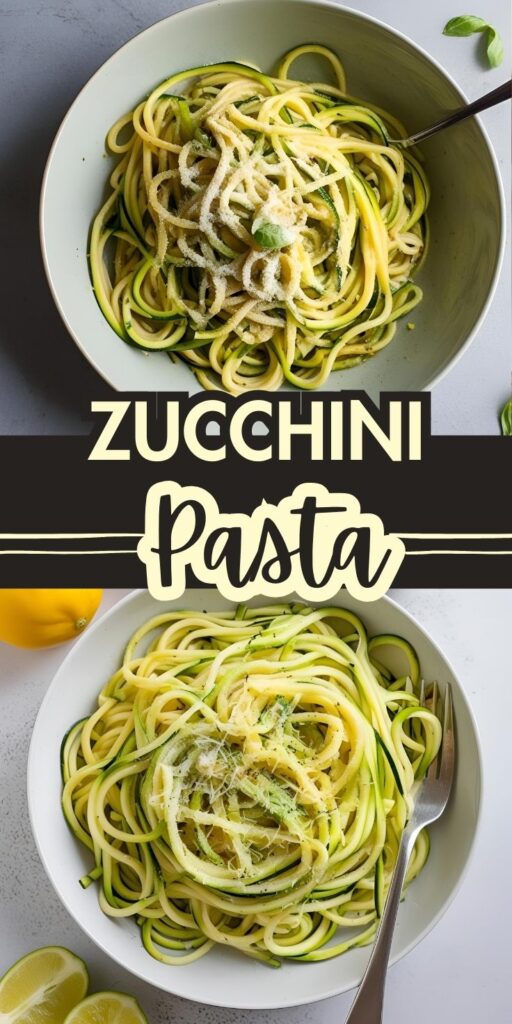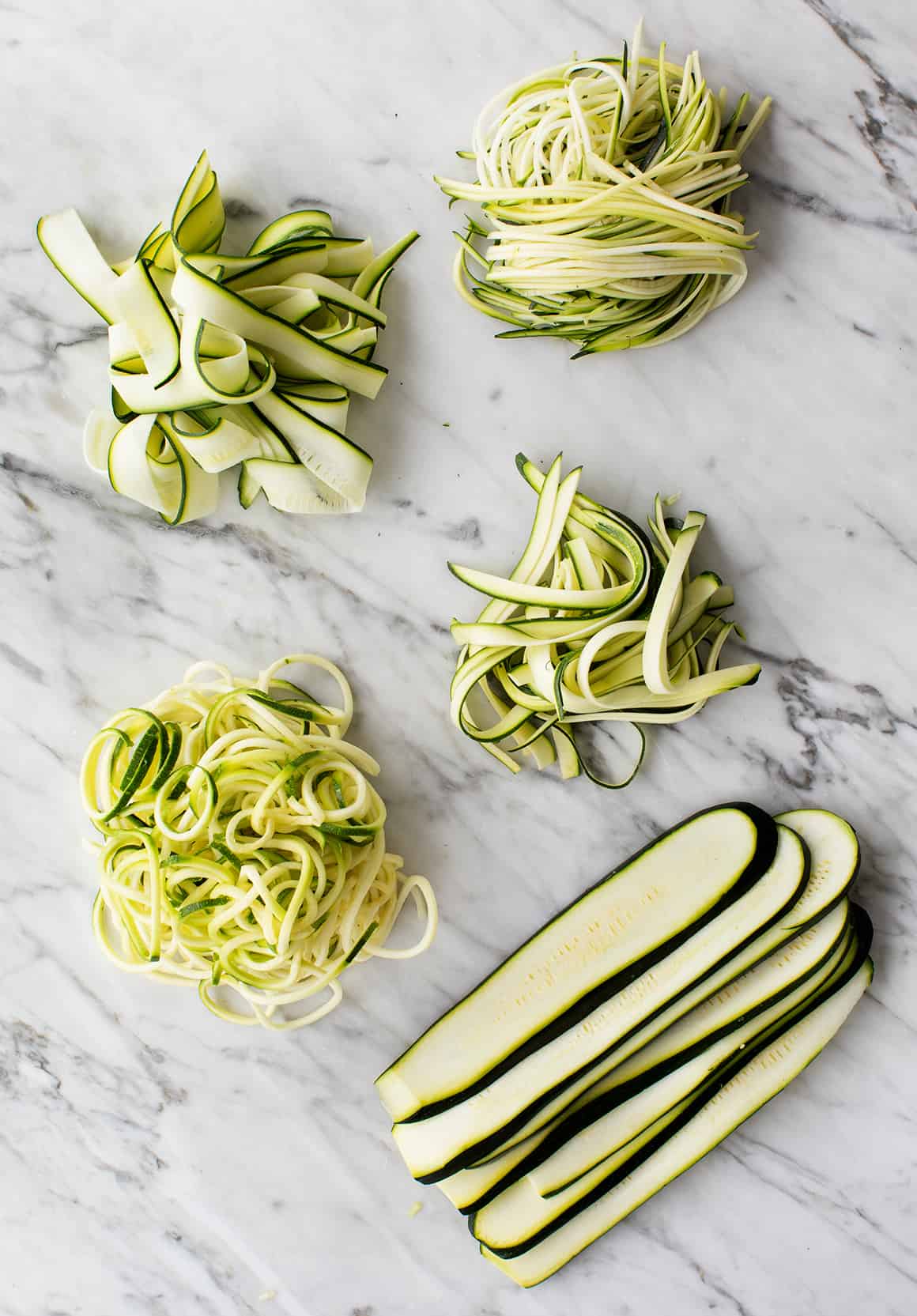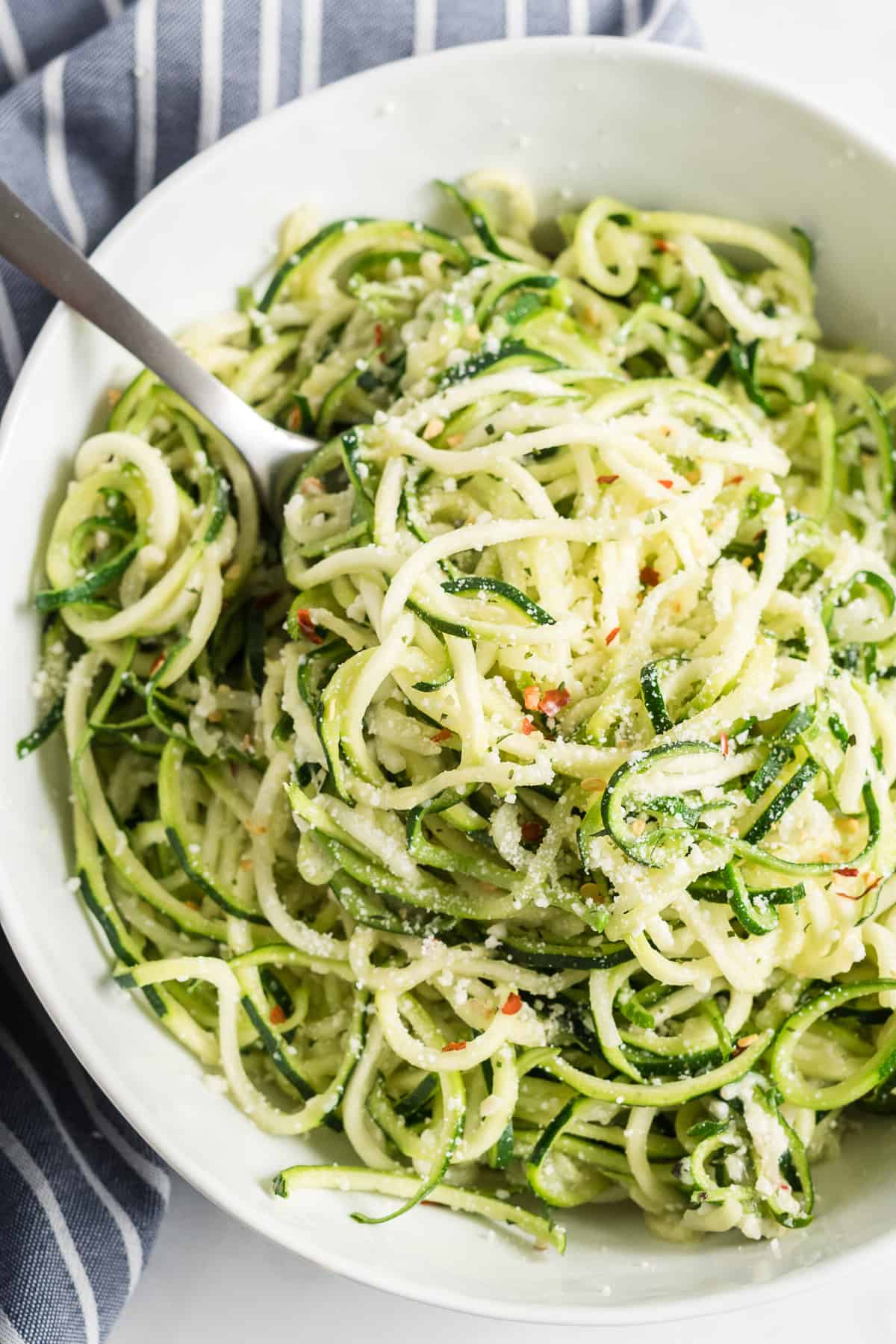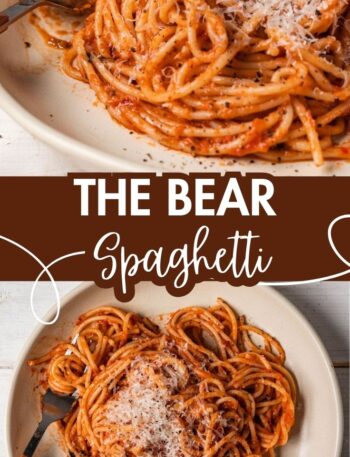
Zucchini-Pasta, auch bekannt als “Zoodles” (Zucchini + Noodles), ist eine gesunde, kohlenhydratarme Alternative zu herkömmlicher Pasta. Aus rohen oder leicht angebratenen Zucchinistreifen hergestellt, überzeugt sie mit frischem Geschmack und knackiger Textur.
Ob als leichtes Sommergericht, Beilage oder vollwertige Mahlzeit – Zucchini-Pasta lässt sich vielseitig kombinieren, etwa mit Tomatensauce, Pesto oder cremigen Soßen. Sie eignet sich hervorragend für Low-Carb- und glutenfreie Ernährungsweisen und bringt Abwechslung auf den Teller.
Mit einem Spiralschneider oder Julienne-Hobel ist die Zubereitung im Handumdrehen erledigt. So wird Gemüse zum Star der Pasta-Küche – leicht, lecker und voller Vitamine.
Zucchini Pasta
Description
Zucchini-Pasta ist eine gesunde, leichte Alternative zu herkömmlicher Pasta und wird aus in feine Streifen geschnittenen Zucchini (auch „Zoodles“ genannt) zubereitet.
Sie ist kohlenhydratarm, kalorienreduziert und eignet sich perfekt für eine Low-Carb-Ernährung.
Zucchini-Nudeln lassen sich schnell in der Pfanne anbraten oder roh als erfrischender Salat servieren.
Sie passen hervorragend zu mediterranen Soßen, Pesto, Tomaten, Knoblauch oder cremigen Frischkäsesoßen. Ideal für eine ausgewogene, vegetarische oder vegane Küche.
Ingredients
Instructions
-
Start by washing the zucchinis and trimming off the ends. Using a spiralizer, julienne peeler, or a mandoline, cut the zucchinis into noodle-like strands. If you don't have a spiralizer, many grocery stores sell pre-spiralized zucchini in the refrigerated produce section.
-
Place the zoodles on a paper towel and sprinkle lightly with salt. Let them sit for 10 minutes to release excess water, then gently squeeze with another paper towel to remove moisture. This step prevents soggy noodles.
-
In a large non-stick skillet, heat the olive oil over medium heat. Add the minced garlic and red pepper flakes (if using) and sauté for about 1 minute until fragrant, but not browned.
-
Add the zucchini noodles to the skillet and toss gently with tongs to coat in the garlic oil. Cook for 2–4 minutes, stirring occasionally, until the zoodles are slightly tender but still firm (al dente). Be careful not to overcook them, as they release water and can become mushy.
-
Remove the skillet from heat. Stir in lemon juice and Parmesan cheese. Season with salt and freshly ground black pepper to taste. Toss again until the cheese melts slightly and coats the noodles.
-
If using cherry tomatoes, add them in step 3 alongside the zoodles, allowing them to soften and release their juices. If adding pre-cooked chicken or shrimp, stir them in during the last minute of cooking to warm through. Top with fresh herbs and toasted nuts if desired.
Nutrition Facts
Servings 3
- Amount Per Serving
- Calories 20kcal
- % Daily Value *
- Total Fat 0.4g1%
- Total Carbohydrate 4g2%
- Dietary Fiber 1.5g6%
- Sugars 2.5g
- Protein 1.5g3%
* Percent Daily Values are based on a 2,000 calorie diet. Your daily value may be higher or lower depending on your calorie needs.
Note
Zucchini Pasta: A Delicious Union of Flavor, Health, and Conscious Living
Zucchini Pasta—often affectionately called “zoodles”—has become a staple in health-conscious kitchens around the world, and for good reason. This simple yet satisfying dish replaces traditional wheat-based pasta with spiralized zucchini, delivering a light, gluten-free alternative that doesn't compromise on taste or texture.
But what truly sets this recipe apart is its unique combination of culinary versatility, nutritional value, and alignment with sustainable, mindful living.
Why This Recipe is the Best
At its core, Zucchini Pasta is refreshingly simple yet endlessly adaptable. Whether tossed in a garlic olive oil sauce, paired with a rich tomato basil ragù, or topped with creamy avocado pesto, zucchini acts as a neutral base that absorbs flavors beautifully. Unlike heavy pasta, it doesn't weigh you down, making it perfect for warm weather or light dinners.
One of its greatest strengths lies in its quick preparation time. With a spiralizer or julienne peeler, you can create pasta-like strands in minutes. It’s a one-pan wonder that goes from raw to tender in less than five minutes of sautéing, making it ideal for busy weeknights.
Moreover, zucchini pasta is accessible to people with dietary restrictions—gluten-free, low-carb, keto, paleo, and vegan eaters can all enjoy this dish with simple ingredient adjustments.
Health and Nutritional Benefits of Key Ingredients
Zucchini is a low-calorie vegetable packed with hydration and fiber, which supports digestion and satiety. It's rich in vitamin C, potassium, and antioxidants such as lutein and zeaxanthin, which support eye health and reduce inflammation.
Pair zucchini with heart-healthy olive oil, which provides monounsaturated fats and antioxidants, and you have a dish that supports cardiovascular wellness.
Garlic, often used in Zucchini Pasta recipes, has antibacterial properties and may help regulate blood pressure and cholesterol. Add a sprinkle of nutritional yeast or seeds (like sunflower or hemp) for a plant-based protein and B-vitamin boost.
When topped with seasonal veggies or herbs like basil, cherry tomatoes, or spinach, the recipe becomes a nutrient-dense bowl of plant-powered vitality.
Sustainability and Mindfulness
Choosing Zucchini Pasta isn't just a healthy choice—it’s an environmentally conscious one too. Zucchini is a fast-growing vegetable with a low carbon footprint and requires less water and land compared to wheat or animal-based products. By using fresh, local produce, you also reduce the environmental costs associated with transportation and packaging.
Additionally, replacing animal-based ingredients (like meat or cheese) with plant-based alternatives supports the shift toward a more sustainable food system, one that uses fewer resources and emits less greenhouse gas.
Preparing and eating Zucchini Pasta can also be a mindful experience. The spiralizing process invites you to slow down and appreciate the transformation of a simple vegetable into something fun and nourishing.
Eating it slowly—savoring the textures and flavors—encourages mindful eating habits that support digestion and reduce overeating.
Tips & Tricks
- Don’t skip draining the zoodles: Zucchini is over 90% water. Salting and pressing the noodles prevents a watery sauce.
- Serve immediately: Zucchini noodles are best enjoyed fresh, as they tend to soften and release water when stored.
- Want it creamy? Add a spoonful of cream cheese or a splash of heavy cream after removing from heat for a light creamy texture.
- No spiralizer? Use a vegetable peeler to create long ribbons for a “tagliatelle” effect.
Serving Suggestions
Zucchini pasta pairs beautifully with:
- Grilled chicken or salmon
- A crisp white wine such as Sauvignon Blanc
- A green salad with lemon vinaigrette
To make it more filling, you can also toss the zoodles with a handful of cooked whole wheat pasta or quinoa for a “hybrid” dish.
Variations
1. Zucchini Pesto Pasta: Replace the garlic and parmesan with 2 tablespoons of pesto (basil, sun-dried tomato, or arugula pesto works well).
2. Asian-Inspired: Sauté zoodles in sesame oil and garlic, then toss with soy sauce, ginger, and crushed peanuts for a noodle bowl with a twist.
3. Creamy Alfredo: Use a simple homemade Alfredo made from butter, garlic, cream, and parmesan, and toss with zoodles for a low-carb comfort meal.
Storing & Reheating
Zucchini noodles are best fresh but can be stored in the fridge for up to 2 days in an airtight container. Reheat gently in a skillet over medium-low heat for 1–2 minutes. Avoid the microwave, which can make them soggy.
Final Thoughts
Zucchini pasta is a versatile, quick, and healthy dish that celebrates the freshness of seasonal vegetables. With only a handful of ingredients, you can create a delicious, satisfying meal in under 20 minutes.
Try different herbs, proteins, or sauces to make it your own—and enjoy the guilt-free indulgence of pasta without the carbs!
Zucchini Pasta is much more than a trendy health dish—it's a symbol of conscious choices in the kitchen. From its fresh flavors and quick prep to its numerous health benefits and low environmental impact, it offers a deeply satisfying experience for body, mind, and planet.
Whether you're new to plant-based eating or a seasoned home cook, this dish proves that simplicity and sustainability can be deliciously intertwined.
Frequently Asked Questions
Was ist Zucchini-Pasta genau?
Zucchini-Pasta, auch bekannt als „Zoodles“ (Zucchini + Noodles), sind spiralisiert oder dünn geschnittene Zucchinistreifen, die als kohlenhydratarme Alternative zu herkömmlicher Pasta dienen. Sie sind glutenfrei, kalorienarm und besonders beliebt in Low-Carb- und Paleo-Ernährungsformen.
Wie bereite ich Zucchini-Pasta zu?
Zucchini kann mit einem Spiralschneider, einem Julienne-Schäler oder einem Gemüseschneider in Nudelform gebracht werden. Anschließend sollte man sie kurz dämpfen, sautieren oder roh verwenden. Wichtig ist, die Zucchini nicht zu lange zu garen – 1 bis 2 Minuten in der Pfanne reichen aus, damit sie nicht matschig wird.
Wie vermeide ich wässrige Zucchini-Nudeln?
Da Zucchini einen hohen Wassergehalt hat, empfiehlt es sich, die Nudeln vor dem Kochen leicht zu salzen und 10 Minuten ruhen zu lassen. Danach mit einem Tuch oder Küchenpapier ausdrücken. Außerdem sollten Soßen nur kurz vor dem Servieren zugegeben werden, um Wasserbildung zu vermeiden.
Welche Soßen passen zu Zucchini-Pasta?
Zucchini-Pasta harmoniert hervorragend mit klassischen Soßen wie Pesto, Tomatensoße, Knoblauch-Öl oder cremiger Avocadosoße. Auch Bolognese oder asiatische Erdnuss-Soßen passen gut. Leichtere, nicht zu schwere Soßen sind ideal, um die zarte Struktur der Zoodles zu erhalten.








